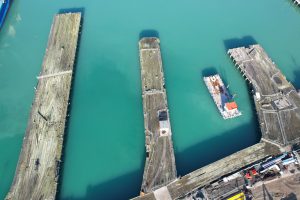
Work has begun to demolish three historical inner harbour jetties built in the 1870’s.
Jetties four, five and six have not been used for several years and are uneconomical to repair, posing health, safety, and environmental risks.
The structures are currently under restricted access, with people unable to walk across or underneath them in day-to-day operations.
Chief Infrastructure Officer Mike Simmers says that while we will reuse as much timber as possible, we will be sad to see such an iconic piece of Lyttelton history go.
“The jetties have seen an incredible amount of history take place, with their construction part of the early growth of the port,” says Mike.
“The area was publicly accessible until 1994, so there are people around the community as well as staff members here who have strong memories tied to the inner harbour.”
The jetties sit amongst operational jetties 2, 3 and 7, also from this period.
However, these continue to be used due to their larger nature and ongoing reinforcement of the wooden structures with steel beams and concrete decks.
LPC’s Civil Maintenance Team will manage the deconstruction, working with Smith Crane and Construction to remove an estimated 66 kilometers of timber over the coming months.
The planned method will pose minimal disruption to the community.
“The removal involves skilled carpenters slowly dismantling the structure while supported by a crane on a barge that will take the pieces to shore.”
Our Environment and Sustainability Team have also worked closely with Biosecurity New Zealand and Environment Canterbury to develop controls for managing marine invasive species as the piles are removed.
The jetties were inspected by a remotely operated vehicle (ROV), highlighting the presence of Mediterranean fanworm.
“As divers cannot access the area due to safety risks, we are unable to remove them by hand, as we have done in other places around the Port.”
We are also focused on reusing as much timber as possible to extend the life of the materials and divert waste to landfill.
“There are a number of opportunities to upcycle the wood, and we are continuing to explore that with local councils and community groups.”
Elements of the jetties are pre-19 century, so Underground Overground archaeologists will be on-site to document the deconstruction of the jetties for historical records.
Once the work is completed, there are no current plans for operations to resume in this area.
Throughout the years, the jetties have taken centre stage in history, such as welcoming royalty to the region, including the future King George V and Queen Mary, during their visit in 1901.
The jetties were also a feature of the Antarctic Expedition era, hosting Scott’s vessel Discovery before a journey to the ice in 1901.
Lyttelton also berthed troopships during wars throughout their history. The inner harbour also hosted several inter-island ferries, with roll-on/roll-off
access for vehicles, from the launch of a dedicated service in 1895 to the end in 1974.
While these are standout moments in history, over the last 150 years, the jetties saw changes in how cargo is transported.
The jetties have had many uses, from horse-drawn carriages along the wharf to steam-powered trains and electric cranes.
The shift to containerisation in the 1980s dramatically changed the landscape of the inner harbour, with more cargo shifting to the container berths along Cashin Quay.
After over 150 years of supporting the region’s growth and trade, they will have new life as the timber is reused in projects around Canterbury.